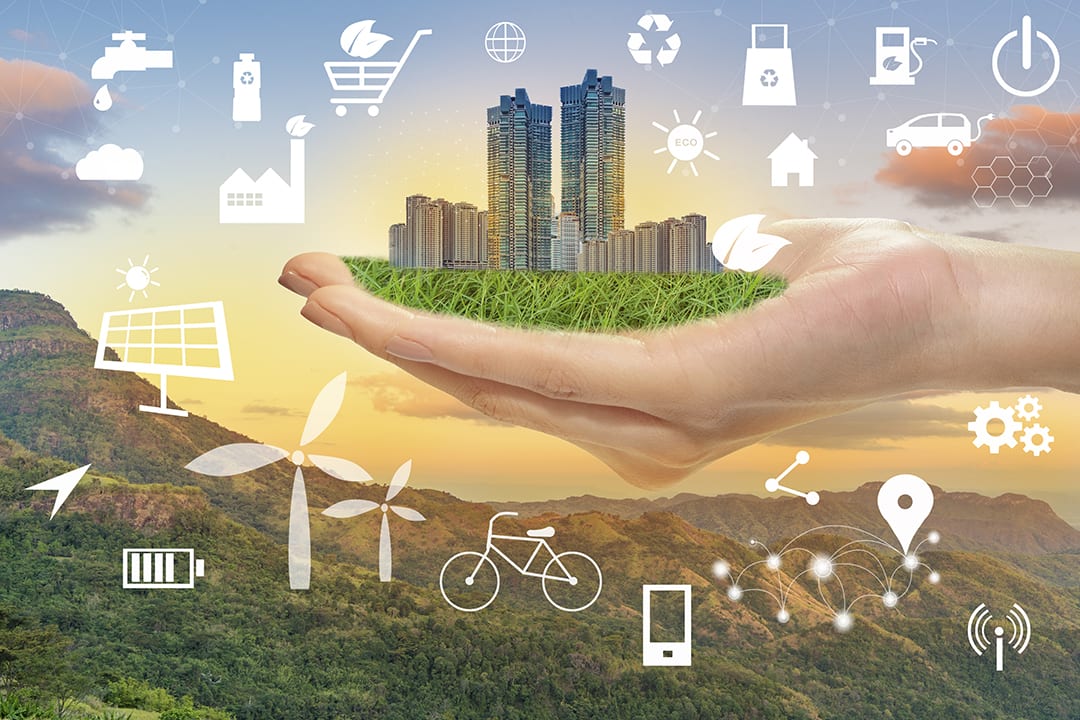4 Trends in Sustainable Site Design

Sustainable site design is a hot topic in the A/E/C industry. As Civil Engineers, Landscape Architects and Planners, we are challenged to integrate conservation into site design, preserving the natural features of the land. We must also think about ways to improve design to promote a healthier and more sustainable lifestyle. Many Architects are embracing the WELL Building Standard (WELL), to address issues of human health and wellness. The importance of incorporating lifestyle into design does not stop at the walls of a building. Skilled site designers excel at creating an engaged outdoor environment that meets the needs of the project users.
BHC is committed to sustainability and here are four integrated site planning trends to consider for your next project.
1. Parking Layout
Parking lots take up a great deal of space and play a big role in site design. Site designers can integrate several sustainable design elements into these spaces and ensure site designs meet the needs of the customer. Sustainable design options for parking lots include shared parking agreements, designated electric vehicle parking spaces and integrated green space.
- Shared parking is a creative way to add green initiative’s into site design. Shared parking benefits include:
- Allow for more green space and less heat-island effect
- Promote alternative mobility and ride share options
- Offset the cost of maintenance
- Better stormwater management

As automakers begin to shift production from traditional fuel burning vehicles to fully electric trucks and cars, the demand for electric vehicle charging stations will increase all over the United States.
Incorporating electric vehicle (EV) charging stations into your site design, or even a redesign to an existing property, is a good way to go green. EV charging stations are necessary to attract and accommodate EV owners who commute for work, school, shopping or dining.
More EVs = less greenhouse gases from fuel vehicles = better public health and a better environment!
2. Green Space
You don’t need a green thumb to go green. Maximizing green space into your site design is easy to do and even easier to maintain. Green spaces benefits include:
- Aesthetics
- Improved air and water runoff quality
- Gathering space
- Promotes public health and wellness
Landscape Architects are masters at designing green space. Consulting a Landscape Architect early in the design process can result in better function and utilization of the site. A straight-forward design of parking islands with trees and shrubs not only hide site features like utility infrastructure they also provide shade to cool the field of pavement and improve air quality. The right landscape design can elevate a code required stormwater detention space into a usable community amenity through simple additions of walking paths and grassed areas.

3. Alternate Mobility
Kansas City, like most major cities, has embraced the alternate mobility shift. Examples include leaders on both sides of the state line committing to a sustainable future beginning with the merger of metro bus lines to form The Kansas City Area Transit Authority and the installation of the downtown streetcar with recent voter approval for expansion.
Designing sustainable infrastructure to accommodate all different modes of transit is a good way to plan for the future. As mobility methods evolve, so can our existing roadways. As the number of cars on the road reduces, fewer lanes will be needed and can easily be converted for:
- Designated bike lanes
- Wider sidewalks to promote walkability
- Bike share and electric scooter parking
- Enhanced streetscapes for outdoor seating and gathering

4. Stormwater Management
Protecting our natural resources in the built environment is a necessary balance. Site designers and developers should think about the land and location of the project and adapt their design around its natural features. Sustainable site design can offer cost-savings while being ecologically responsible.
Stormwater management and mitigation offers a number of sustainable Best Management Practices (BMPs) in site design.
Low Impact Development (LID) is a design practice that site designers use to integrate a site’s natural features to emphasize conservation and protect water quality.
In the built environment, stormwater quality is reduced by pollutants from manmade surfaces and structures. Incorporating water quality options such as rain gardens or bioretention basins and bioswales maintain stormwater runoff effectively and help offset pollutants absorbed into the watershed.
To better help us understand sustainable design, we sat down with Mike Makris, P.E., who is one of our go-tos for sustainable design. Makris’ knowledge has landed him several speaking opportunities to local architects, professional and college organizations.
We asked Makris, “where do you see sustainable design in the next three to five years?”
Speaking to site sustainability, I believe it has followed, and will continue to follow changing lifestyle trends. The millennial generation consumed mixed use space, and present indicators are that Gen Z will too. This has created opportunities for urban design to consider alternate mobilities, electric vehicles, parking reduction, and outdoor engagement spaces.
Alternate Mobilities – the goal of mixed-use development is to create a place that people can live, work, play, and shop without the use of a car. This type of development fosters walkability and is supplemented by other mobilities such as e-scooters, bikeshare, rideshares, and public transit. Alternate mobilities are seeing growth not only from the physical space being built to support them, but from technological advances and 5G adoption.
Rise in EV adoption – As Electric Vehicles (EVs) are becoming more affordable, we are beginning to see 25% year over year growth in EV ownership. Sustainable designers need to think beyond just the charging station. They need to consider how people’s travel habits will change. EV drivers will not stop at the local gas station, as they will charge at home. On long road trips, the stop to refuel will not be five minutes, but an hour, changing the role of travel centers. Real Estate Owners are beginning to consider the role of EVs at their property, chargers are quickly becoming essential amenities in multifamily and hotel developments.
Parking Reduction is among the most basic sustainable solution we can implement as it allows us to replace blacktops with greenspaces. This reduces heat islands, and impervious area which helps with stormwater control.
Emphasis on outdoor engagement is being adopted in sectors of development beyond mixed use. We have seen healthcare facilities include things as simple as a walking trail around their property to something substantial like an outdoor therapy garden. On the office side, companies have begun to encourage and teach mindfulness, outdoor spaces give employees a place of refugee from the technology overload that now exist within our office buildings. In the retail realm, the pandemic has created a heightened desire for outdoor dining and entertainment. These design types are better connected to nature and bring with them creative landscape opportunities.
Millennials are the experience lifestyle generation; our Gen Z counterparts share many tendencies and are the most environmentally concerned generation. As Gen Z enters the work force and their buying power increases, I do not see the consumption of these lifestyles slowing down. Sustainable design is forward thinking, but when done right it can be future proofing.
Makris also had thoughts to share on rating systems.
Early sustainability rating systems focused heavily on building design and left the outdoor space to the creativity of site designers. More recently the American Society of Landscape Architects led an effort to implement The Sustainable SITES Initiative (SITES) rating system that is now administered by the Green Business Certification, Inc. (GBCI) along with LEED and WELL rating systems.
Regardless of sustainable certifications, there is always value in incorporating some of these site planning strategies we mentioned.
Sustainable site design is achievable and the possibilities are endless. If you’d like to learn more about sustainable design and how to incorporate these methods into your next project, No Problem. Connect with our experts and get started today.
